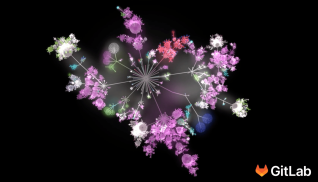On November 17, Mike Knoop and Noah Manger of Zapier sat down with GitLab’s CEO Sid Sijbrandij to discuss the way the two companies approach the challenge of scaling communication as a company grows. This transcript has been lightly edited for clarity.
The heartbeat of our organization is our weekly Friday Update posts that everyone at the company writes. The problem is that as we’ve grown, it’s become a tremendous amount of information. We’re really good at generating the firehose of content, but not as good at consuming it. So I’d love to learn what processes you use at GitLab and if you feel like you’ve got a good grip on this problem?
We have a #working-on Slack channel but I’m working on killing it because I just don’t care what people in another part of the company are working on. I just don’t care. There are just too many people at 200 people.
What works really well for us are the functional group updates. Every day of the week there’s a presentation (for a maximum of 25 minutes) by a team lead with a slide deck of what they’re working on, and there's an opportunity to ask questions. So you get to stay updated about what all the development teams are doing, what sales is doing, what marketing is doing, what legal is doing, what partnerships is doing. It’s on a three-week rotation so 15 different functional areas and then we start over from the top.
Do you measure how many people consume this content?
Live in the call it’s about 50 but it differs on the matter. It’s planned for every single day. We hadn’t scheduled them for a month or two and everyone in the company reported feeling out of touch about where the company was going and what people were working on.
We are doing asynchronous stand-ups, but it’s just for something that’s a high priority project and there’s a chance of delay that we can’t afford. Right now there are three groups on asynchronous stand-ups that are super high-priority projects and we want to make sure that nobody’s blocked. So someone posts a message saying “Asynchronous stand-up for today” and then everyone posts in the thread what they’re working on and may be blocked on.
Normally we don’t do it and we just work in GitLab issues. When you start working on something you assign your name to it, and so if you want to know what someone is working on you see what issues are assigned to them.
Why did you choose to do functional updates as videos rather than written?
It allows for more interaction. Yesterday my update had three topics and I had a slide for each. People ask questions mostly in the chat feed in Zoom. Sometimes if they have an elaborate question I’ll ask them to explain more verbally. We spend 15-20 minutes on people asking questions. That’s what we want — it’s not typical — but that’s where we want to go. Sometimes people have a lot to present and talk for 20 minutes, but we want to try to split those up and constrain the presenting part to 10 minutes.
And if they’re over in 10 or 15 minutes and nobody has any questions, that’s great.
And one thing: the presentation slides have to be linked to in the invite before the presentation starts. People have to be able to invest one minute to click through the presentation to see if they need to join the call, or they can just say “This is great and I don’t need to join.” And obviously everything is recorded: it’s put into our Google Drive and you can see everything and the ones that are able to be public will be posted every Friday.
Is it typical for someone to join every update?
I join about two thirds of them.
So if someone were to join every one it’d be a two-and-a-half-hour time commitment every week?
Yeah, but you won’t be asked any questions so you’re able to multitask and zone out if you don’t need to pay attention.
You’re global, so how do you deal with time zones? Do you rotate it around so other people are able to join?
You’re not expected to join at all. These are optional; join them if you want to. But time zones are the bane of our existence. Most of our people are either in Europe or the Americas, so we do this in our most convenient time zones. So our functional updates are at 8am Pacific and our team call is at 8:30am Pacific. There’s been a trend of scheduling meetings over this but we’re trying to prevent that.
What percentage of content about the company do people consume over video versus writing?
It depends. It depends on how they like to consume content. If you’re good with written content, you can get by with the handbook and the presentations. If you like to consume it by listening and hearing people interact, then the video calls are a good way to do it. What’s important is that we make both ways available and then people can do it as they please.
If you’re good with written content, you can get by with the handbook and the presentations. If you like to consume it by listening and hearing people interact, then the video calls are a good way to do it. What’s important is that we make both ways available and then people can do it as they please.
And some people might not care so much! Some people are happy being an open source developer and don’t care about the machinations of a company and that is A-OK. We’re not going to force you to sit through this or check your attendance rate. That is just fine.
But some people really care and they care about all the aspects. They joined a startup because they want to know what’s happening. For example, when we were doing fundraising we had a fundraising Slack channel and people were asking questions like “What’s the liquidation preference?” And that’s great. If you’re interested we’re not trying to shield you; we don’t want you to get too distracted but it’s there if you want to dive in.
Do you find people have anxiety around keeping up with information and being concerned they’re not missing things?
What people report is that starting here is overwhelming. The first month is a dark place. We never have people quit during that time but everyone reports that it’s super hard on them. We have one onboarding issue that has about 100 checkboxes you need to check off. And we try to have it all go by what you do on Day 1, Day 2. But it’s very overwhelming. We try to figure out what to cut, but everyone says “No, it’s good to have it all there.” When you first join you have access to the entire map of GitLab so you have to constrain your view.
Are there other things that you do to help teams know what other teams are doing around the organization?
Well the handbook is really important. That contains all our processes, all the different departments, how they operate, who’s responsible, what Slack channels they’re on, which issue trackers they use; our definitions; our stages in the sales process. Everything should be in there. It’s hard to get right, so it’s a constant focus of my attention. But the idea is if you want to make a change to the company you propose an edit to the handbook, make a merge request, and then if you merge it you announce it. It’s the best handbook in the world; there’s lots of room for improvement, but it’s good and lets you see how lots of different parts of the company operate.
And of course we use our own tools. So our customer success team uses an issue board so you can see what they’re doing and what stage it’s in. So we try to use our issue boards and our static websites so you can peer into any part of the company.
One thing we’re still getting better at is how to expose metrics. We already have a good metrics sheet that’s up to date, consuming all the revenue models and everything we have, but I want that to be a real-time thing that looks a bit prettier and has some better graphs.
Another thing we do to keep everyone posted is everyone gets the investor update. So every single month, between the 10th and 15th, we send out an investor update about what was good, what was bad, and all our core metrics and everyone in the company gets it.
Do people find that helpful?
I think people find it helpful. I believe if you want people to invest in the company you have to treat them like investors – which they are, because they have options. I think what people pay attention to most is runway (months of cash remaining) and what’s bad.
One thing we’ve heard is that people want a weekly set of highlights of the things that they need to know. Do you do anything like that?
I’ve never heard that. If your communication is any good, you repeat yourself a lot. I have a #ceo Slack channel, so hopefully what I say there is congruent with what I say in the investor update is congruent with what the leaders in marketing and sales are saying, etc. We’re not trying to make it the same message, but in a perfect world it’d be the same message.
If your communication is any good, you repeat yourself a lot.
So no, I’ve never heard the need for a summary. If I ever need to go find what sales was doing two weeks ago, I’d go find their functional update from two weeks ago.
If I switched to a new product team and I wanted to know what my new team has been working on, what would I do?
You’d look at the functional updates. And also you could join the kickoffs and retrospectives, which happen every month and are broadcast live on YouTube. So that’s another channel you could use.
At which stage in your growth did you start doing those functional updates?
I don’t know exactly. About 50 engineers. But it’s also because this is an open source project and people who are contributing to the project but aren’t part of GitLab are wondering what’s in the pipeline and what’s happening.
Do you have any internal blog or tools that people log into to get information about what the company is up to?
No. There’s the handbook, but for regular updates that’s what the functional team updates and issue boards are for.
Do you feel like there’s things that aren’t shared that should be? Are those functional updates high enough bandwidth or frequent enough to get everything across?
With our kickoffs, because they’re live broadcast, some of our product managers would get into presentation mode, like “Everything’s going to be wonderful!” There’s going to be some of that, but I think it could be more measured and raw. In our retrospectives there’s a more of that. People are also used to asking hard questions and getting praised for that. You say things like “Wow, that’s a hard question. That’s the best question we’ve got.”
If I’m a product manager and I’m about to release something that will affect the product and I don’t have a functional update this week, what’s the best way to do that?
For the company, post in the general chat channel that will be consumed by many people and you mention the related people. If you need it externally you could do a blog post, but usually you could just do it in the issue and then tweet it from your personal account and it will be retweeted by GitLab.
So you depend on Slack for urgent notifications?
Slack is great for urgency. It’s its downfall as well.
What have been either pain points or surprises as you’ve gone from 100 to 200 people?
I think a pain point we’re experiencing right now is our team call. It’s too many people. We try to rotate people now, but after about 150 people, people lost track. And if you lose track you lose interest. So we’re thinking about getting a smaller group of people together, maybe even 7-15, and having them talk every day for a sustained period so you get to know them and then you switch up the groups.
Also, overuse of @channel mentions is a pet peeve. It’s only allowed if it’s urgent and important but people use them if it’s only urgent or only important. Those should just be posted without an @channel or @here mention. If my Slack always has a constant red thing then I’ll stop paying attention. It’s a tragedy of the commons.
Do you have any tricks for organizing Slack?
There’s a few special channels: #thanks where we call people out for helping that gets about 10 posts a day and that’s one of my favorite channels.
There’s an #emotional channel where you can just complain about shit. And that’s allowed and encouraged and we give teddy bear emojis back.
How many channels do you have?
Hundreds. More channels than people.
How do people navigate that when they join? Do you do anything to help them figure out which channels to join?
It’s organic. These people already feel overwhelmed, do you want to give them more channels? It just gets worse. And in the handbook you can see what the channels are for your group.
Since we’re talking about cross-team collaboration, can you tell us about your summit?
We try to do it every nine months and it’s forbidden to organize functional meetings there. So you can’t meet with the just sales or marketing team. Instead we have an 'unconference' based on the Lobby Conference, that’s built on user-generated content. We have two half days where people propose subjects, people vote on them, and someone kicks things off for five minutes and then a group of 15-20 people discuss it for 50 minutes.
You know the people in your team already, so we said “Please, please, please meet with other people.” The top two sessions at the last one were on avoiding burnout and how to keep yourself motivated while working at home. I was glad to see people organized sessions like that because we can do the purely job-related stuff at other times.
Well thanks. This has been really great and has challenged some of our assumptions. We’ve been assuming that we’re generating all this content and we need to figure out what the right curation layer is. But it sounds like you’ve been very successful at reducing the amount of content that’s generated in the first place but forcing it all to go through those channels, which solves the curation problem that way.
About the guest author
Noah Manger is a product manager, designer and developer, currently leading the Internal Tools team at Zapier. He lives in Portland, Oregon.
Cover image by Alexandr Bormotin on Unsplash.




